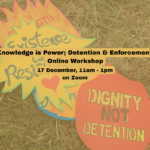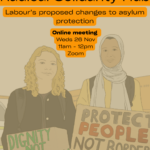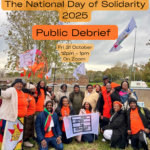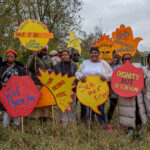Throughout the Still We Dream series, we’ll hear from grassroots migrant rights and racial justice organisers across the United States talk about how they’re building their movements in Trump’s America and tackling racial privilege not just beyond the movement – but to transform it within.

The election of Donald Trump as the next US president has shaken the world. Not that Hilary Clinton was much of a champion for migrant rights, but what Trump’s victory reflected in the hearts and minds of the American people has been a sobering wake-up call. Even here, the few days after the US election were dark, with activists and community organisers visibly shaken. As with Brexit, we had all been warning of the danger but when it actually arrived, found we couldn’t believe. How could such a brazenly racist and sexist figure be elected the most powerful position in world politics? And now, what?

Over the past three years in the United States, in the face of a record 2.5 million deportations under Obama, the nationwide Dream Movement has been heading towards the most significant victory the immigrant rights movement had seen in 40 years’. It had gone far, alongside Black Lives Matter, towards restoring faith in the enduring power of social movements to shake the ground and change the world – even in the USA. The election of a president who has declared war, not just on a movement but on a people, could have been a death blow. But there are encouraging signs that this movement is rising like a phoenix from the ashes, learning, mobilising and connecting faster than ever before.
In this series of blog posts, we’ll be interviewing migrants and organisers from across the United States, who’ll share experiences and insights from this extraordinary moment in their movement’s history. They’ll talk about everything from winning the public debate to building rapid-response systems to immigration raids. And we’ll be thinking about what might work for us, to meet the challenges ahead for UK movements against racism and for migration justice.
“I am genuinely afraid, but I firmly believe in the power of the people. I am heartened by all the people, especially young people in the streets. That is the movement I come from. We must disrupt, obstruct, hold each other, strategise, organise, and fight like we never have before. “
– Cindy Wiesner, national coordinator for the U.S.-based Grassroots Global Justice Alliance

During a presidential campaign dominated by scandalous allegations of sexual assault and racial slurs against immigrants, refugees, Muslims, Mexicans and the Black Lives Matter movement to name a few, Trump’s intentions for his first 100 days in office have been gut-wrenching. He has pledged to begin his first term with the forced removal of more than two million undocumented people from the country and completely close US borders from ‘terror-prone regions’ and impose ‘extreme vetting’ on all people coming to the United States. He has pledged to introduce a two year mandatory minimum federal prison sentence for anyone illegally re-entering the country having been deported and build a ‘deportation force’ dedicated to expelling a jaw-dropping 11 million people.
Kevin Appleby, senior director of international migration policy at the Center for Migration Studies of New York, told the New York Times that:
“[Trump] would have to conduct a sweep, or raids or tactics such as those, to reach the numbers he wants to reach. It would create a police state, in which they would have to be aggressively looking for people.”
Sarah Lazare writes: “In interviews with grassroots organisers who work with undocumented people across the country, AlterNet was repeatedly told that the task, now, is not to petition or persuade the Trump government, but to fortify communities on the local level and coordinate resistance nationally, in order to levy the most effective and strategic defence of people at risk. At a time when many are upset, scared and willing to take bold steps to protect their neighbours, communities and families, these organisers are working to develop infrastructure for a nationwide fightback.”
This movement has a long and rich history of solidarity activism stretching well beyond the more famous examples of the civil rights movement – most notably the Cities of Sanctuary, which will be the topic of next week’s blog. Sanctuary cities offering asylum and protection for exiles and migrants date back thousands of years and have been associated with religious traditions from Christian, Islam and Judaism to Buddhism, Hinduism, Sikhism.
In the United States the tradition goes back to 1979, when public pressure saw Los Angeles ban police officers from asking arrestees about their immigration status. Throughout the 1980s this was replicated in many states and hundreds of religious congregations hid and transported refugees fleeing conflict and US-backed death squads in Honduras, El Salvador and Guatemala. According to Puck Lo, writing for the Nation, “At the movement’s height, more than 500 congregations nationwide hosted refugees and operated an underground railroad that moved migrants from Mexico to cities all over the United States and as far north as Canada.”
Today, there are over 200 sanctuary cities spanning the United States. In the next Still We Dream blog, we’ll look at Trump’s tactics to intimate and eradicate these sanctuary cities, and interview Peter Pedemonti, co-founder and director of the New Sanctuary Movement in Philadelphia, about how people are responding: how communities are building their own sanctuary spaces, challenging churches, mosques and other religious buildings to return to their sanctuary roots and ultimately taking the sanctuary movement back to its beginnings – in the streets.
In the meantime, you can show your opposition to President Trump tomorrow, on the day of his inauguration, by joining one of many Bridges Not Walls actions happening across the UK and around the world. Find out more at the website bridgenotwalls.uk or on facebook.
Read More of the Still We Dream series
-
The New Sanctuary Movement says we must go big, bold and migrant-led – interview with Peter Pedemonti in Philadelphia
-
Mijente says living with Trump is teaching us to create, not wait for, the world we want to see – interview with Reyna Wences in Chicago

















Discussion: